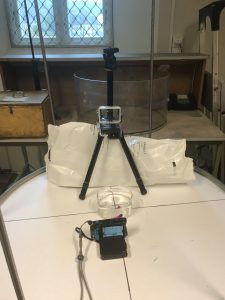
Bottom Ekman layer without a rotating table
Can you do a bottom Ekman layer demonstration without a rotating table? That’s the kind of challenge I like :-)
The way I’ve previously showed bottom Ekman layers is by spinning up a cylindrical tank on the rotating table until it reaches solid body rotation, adding dye crystals to visualise the circulation later, and then stopping the tank to create friction at the bottom (and the sides, but we are mainly interested in the bottom since we want a bottom Ekman layer) as the water continues moving but comes under the influence of friction. But what if we just invert the whole thing?
Move the “bottom”, not the water
My initial idea was to use a Lazy Susan (you know, the kind of tray on a swivel base that you can use for your jam and honey etc on your breakfast table, but which you shouldn’t turn too rapidly (ask me how I know)) and to have a cylindrical vase sit on it, which will then be put in rotation and will rotate around and under the (initially still stagnant) water. The friction with the moving vase will then lead to a bottom-intensified circulation.
Problem here: While I have a Lazy Susan at home as well as a vase that would work as “tank”, I am currently in Bergen where I don’t have access to my own equipment. Instead, though, I have access to a rotating table in GFI’s basement which I used to simulate my Lazy Susan idea (Cool, eh? Simulating a non-rotating-table situation on a rotating table ;-)).
That worked quite well, didn’t it?
This, btw, is what the setup looked like:

So how would that work as kitchen oceanography without an actual rotating table?
The physics themselves obviously work in this setup. However, they will be really difficult to observe for several reasons:
- Scales. A small dish (like the one I used; for comparison see the usual tank in the background in the picture above) makes it a lot more difficult to see what’s going on, and in my case the circulation is quickly influenced by the sides of the dish (which is obviously not what we wanted).
- Rotation. It’s not difficult to set a Lazy Susan into rotation, but I imagine it will be quite difficult to keep it at a constant rotation for any length of time. But you will only see the nice spiral for as long as you keep the rotation constant. As soon as it changes, so will your currents and that will be clearly visible in the dye (which is why you put it in in the first place).
- Documentation. If you want to document your experiment, if want to have your cameras co-rotating with the Lazy Susan, it’s going to be quite difficult to install them (but maybe you would just want one that sits stationary above the center of rotation? That would obviously be easy to do with a tripod)
So all in all: it was a nice idea, but either I haven’t thought it through well enough, or it is a whole lot easier to do with a rotating table. I would imagine that it’s quite hard to observe when you don’t know very well what you are looking for, so it is unfortunately not useful as a demonstration to introduce people to the topic. What do you think? Any suggestions on how to improve this and make it work at home?